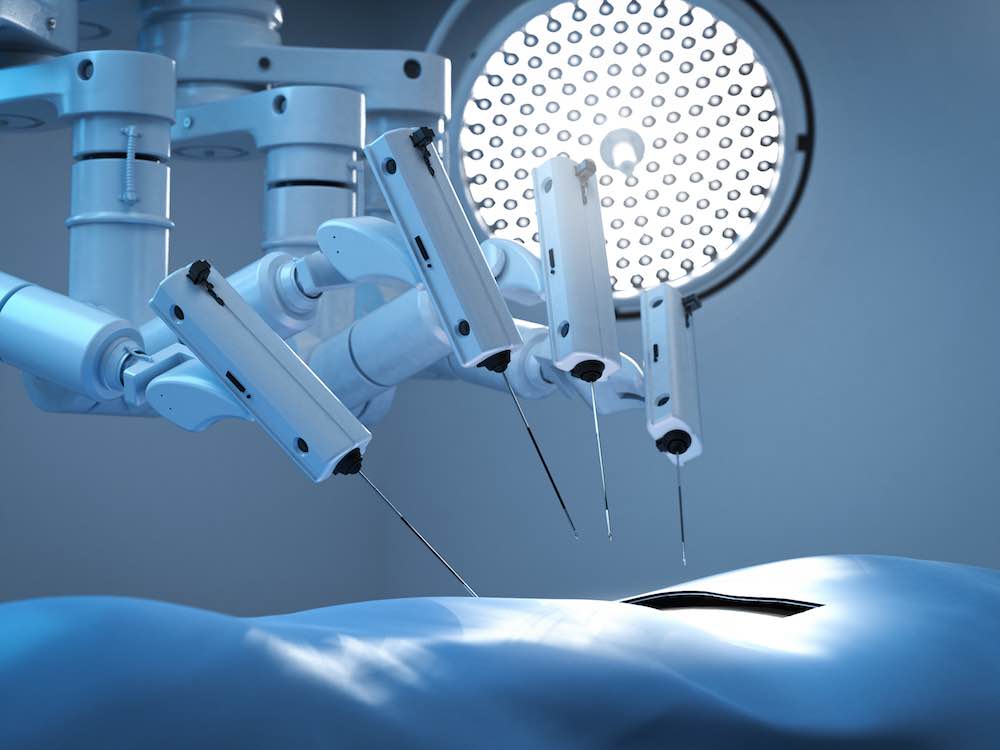|
Listen to this article  |

What if you could design and build a surgical robot that helps doctors perform less invasive, more precise operations and achieve better patient outcomes? While the results of any surgery depend on the challenges of the specific case and the skill of the surgeon, better tools support better care.
Here’s how next-generation motion engineering can help you develop the next generation of surgical robots.
Place the arms as close together as possible
Conventional surgical robots include large columns with multiple arms holding a tiny camera and various instruments such as scissors, graspers, needle holders, clip applicators and more. Depending on the surgery, the ideal procedure is performed through a single, small incision that must simultaneously accommodate the visualization camera and any needed instruments.
If you ask any surgeon, they will tell you the ideal angle of approach for the camera and instruments into the incision site is as parallel and close together as possible—both to minimize trauma and to eliminate any discrepancy between the camera view and the angle at which each instrument operates.
Achieving an identical angle of approach is, of course, impossible, as the instruments can’t occupy the same space. Today’s instruments are very thin and compact, however. It’s the single-column, multiple-arm design of conventional surgical robots—plus the sheer bulk of their arm joints—that limits the angle of approach when multiple instruments are deployed. This is the main challenge to overcome when designing the next generation of robots.
Minimize the axial length of arm joints
Standalone arms provide much greater flexibility in positioning compared to the conventional design, allowing multiple arms to be aligned in a plane much closer to parallel. To further approach the parallel ideal, the bulk of each arm must be minimized.
The limiting factor for how closely together the arms can operate is the axial length of the arm joints. You need a motor and gearing system that delivers all the required torque with the shortest possible axial length. Every millimeter saved without compromising performance helps surgeons work more effectively and creates an important market advantage for your surgical robot.
Start with the gearing
High-torque motors with short stack lengths are key to achieving optimum torque while minimizing axial length, total volume and weight. However, beyond the stack length of the motor itself, the gearing and feedback devices also need to be tightly integrated within the joint.
Ultimately, it’s the gearing that translates the relatively high-speed motion of the motor into the lower speed and higher torque needed to move the load of the robotic arm at the optimum speed, precisely position it, and hold the load steadily in place. Because the selection of gearing also impacts the axial length of the joint, this is the place to start in creating your design.
The required speed, performance and load points will determine the appropriate gear set. No matter what ratio is required, this application calls for strain wave technology, also known as “harmonic” gearing.
Strain wave gearing provides three indispensable advantages:
- 1. It enables the most compact axial integration within the joint.
- 2. It offers relatively high gear ratios—typically ranging from a gear reduction of 30:1 to 320:1—to accelerate/decelerate loads smoothly and position them precisely.
- 3. It operates with zero backlash to minimize any unwanted movement that could potentially affect the precision of the procedure or induce unnecessary trauma.
Match the motor to the gearing and thermal requirements
Having specified the appropriate gear technology and ratio, you can select a motor based on the gear ratio, the speed at which the arm must run, and the mass it needs to hold. Thermal rise when operating at typical or maximum load can also be an important consideration, as excessive heat in the tight confines of the joint can damage gearing lubricant, encoder electronics and other components in close proximity. A motor that can deliver full performance at a lower thermal rise is desirable.
Take advantage of the D2L rule
As part of your motor specification process, you can further reduce axial length through an often-overlooked principle of motor design referred to as the D2L rule.
In robotic joint design, the diameter of the motor is typically of minor concern. To enable robotic arms to operate as closely together as possible, you instead need to minimize the axial length. The D2L rule allows you to trade off a larger diameter for a significantly reduced axial length. Here’s how it works.
In the frameless motors used in robotic joints, torque increases or decreases in direct proportion to changes in motor length, but as the square of changes in the moment arm of the motor. In other words, under the D2L rule, doubling the moment arm—and thereby approximately doubling the overall diameter—produces a fourfold increase in torque.
Or, more relevant to surgical robot design, doubling the moment arm allows you to reduce the stack height by a factor of four while maintaining the same torque. This is a huge advantage when your design priority is to achieve the most compact axial length.
For next-generation surgical robot performance, choose next-generation motors specially designed for robotic applications. This will help you accelerate your development time and deliver surgical robots that allow doctors to operate instruments as close together and as close to parallel as possible.
Better tools mean better healthcare and a healthier surgical robotics business.
Credit: Source link


Comments are closed.